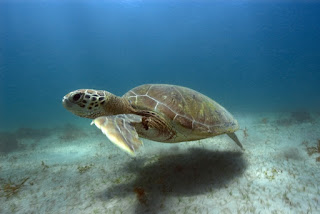Fast Facts: Atlantic Green Turtle
A New Year brings fortune, happiness, and luck. What better species is there to start off 2023 than the turtle?
The Atlantic Green Turtle : Chelonia mydas
Description: One of the most identifiable turtles in the world, the Atlantic Green Turtle has an un-ridged smooth shell that varies from light brown to olive green with dark brown mottling and hexagonal markings resembling plates. Sizes range from 35-48 inches in length and 300-350 pounds in weight; the Atlantic Green Turtle is the largest hard-shelled sea turtle in the world. Its four flippers each have one claw, and every Green Turtle has a tail, although males typically have longer and thicker tails. There is no notable size difference between males and females.
Habitat: The Atlantic Green Turtle is most often found in the shallow coastal waters of coral reefs, bays, and inlets near the western and eastern US coasts. However, their distribution ranges from all over the world, and Atlantic Green Turtle nesting sites are located in the waters of over 80 countries.
Diet: As the only herbivores of sea turtles, the Atlantic Green Turtle's diet consist of almost entirely of seaweed (sea grasses) and green algae. Occasionally, they will also eat crustaceans and jellyfish.
Behavior: Female Sea turtles are known to return back to their nesting sites to lay their eggs (which number around 110-150). After hatching, the hatchlings make their way over a stretch of sandy beach to reach offshore (open ocean) areas, where they'll spend the rest of their lives. The hatchlings are able to determine where the ocean is because of an innate instinct to crawl toward the brightest area, the ocean, and away from the shaded vegetation of the land. Besides mating which occurs during the breeding season on foraging grounds, Atlantic Green Turtles are solitary. Additionally, they'll travel thousands of miles from foraging to breeding grounds, where multiple females may gather to lay eggs. A female may be anywhere from 25-45 years old before she breeds; this is unsurprising as Green Turtles can live up to 70 years. And every two to five years, females will return to breeding sites to lay eggs again.
Conservation Status: The conservation status of the Atlantic Green Turtle is in between Endangered and Threatened, depending on the region, but it is officially considered to be Endangered. Major threats to this species include shore development, which disturbs the nesting sites that the turtles return to each breeding season, and commercial fishing, which involves machinery and nets that harm wildlife. Pollution is another problem as marine wildlife may swallow or get tangled in plastic that is tossed into the ocean.
Unique Traits: It may be obvious to some that the Atlantic Green Turtle is not actually green (it's a new year, I had to sneak in some sarcasm.) As stated above, the Atlantic Green Turtle is often brown or olive colored; its name actually comes from its green fat and cartilage and not its outward appearance. Also, Atlantic Green Turtle heads are typically considered to be small in comparison to their bodies and other turtles. However, Atlantic Green Turtle heads are unable to retract despite their small size because their flat shells provide no room for retraction. This is unusual as other turtles are able to retract their heads. Note that no sea turtles are able to retract into their shells.




Comments
Post a Comment